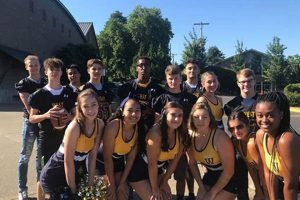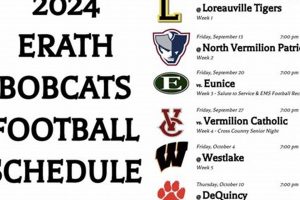Successfully joining a college football team without an athletic scholarship requires a combination of talent, dedication, and strategic planning. This involves targeting institutions where a prospective student-athlete has a realistic chance of earning a roster spot based on their abilities and the team’s existing needs. The process often includes attending open tryouts, showcasing skills to coaching staff, and demonstrating a commitment to the program.
Earning a place on a collegiate roster through this route offers significant advantages. It provides an opportunity to compete at a high level, potentially leading to scholarship opportunities in later years. It also offers valuable experience in time management, discipline, and teamwork, skills beneficial both on and off the field. Historically, many successful college and professional players began their careers as walk-ons, proving that dedication and hard work can overcome initial obstacles.
Factors influencing a prospective walk-on’s success include the specific division level (NCAA Division I, II, or III, NAIA, or junior college), the program’s existing roster depth, and the coaching staff’s philosophy regarding walk-on athletes. Understanding these elements is crucial for individuals seeking to navigate the challenging but rewarding path to college football.
Tips for Prospective Walk-On Athletes
Successfully joining a college football team as a walk-on requires careful planning and execution. The following tips offer guidance for navigating this challenging process.
Tip 1: Realistic Self-Assessment: Honest evaluation of one’s skills and physical attributes is crucial. Comparing oneself to current players at the targeted program provides a benchmark for determining potential fit.
Tip 2: Targeted Program Selection: Researching programs known for accepting walk-ons and having needs at specific positions increases the likelihood of success. Smaller schools and lower divisions often present more viable opportunities.
Tip 3: Early Contact with Coaching Staff: Reaching out to coaches directly, introducing oneself, and expressing interest demonstrates initiative and allows for establishing a connection. Highlighting relevant skills and experience is essential.
Tip 4: Strong Academic Performance: Maintaining a solid academic record demonstrates commitment and responsibility, factors coaches value in potential walk-ons.
Tip 5: Impeccable Physical Conditioning: Arriving at tryouts in peak physical condition showcases dedication and readiness to compete. Focus on strength, speed, and agility relevant to one’s desired position.
Tip 6: Highlight Film Preparation: A well-organized highlight reel showcasing skills and athleticism is critical for capturing coaches’ attention. Focus on quality over quantity, emphasizing impactful plays.
Tip 7: Persistence and Resilience: The walk-on process can be challenging. Maintaining a positive attitude, demonstrating perseverance, and accepting constructive feedback are essential for long-term success.
Following these guidelines increases the probability of a successful walk-on experience, paving the way for a rewarding college football career.
Ultimately, earning a spot on a college football roster as a walk-on requires dedication and a strategic approach. By understanding the process, preparing diligently, and demonstrating commitment, aspiring athletes can increase their chances of achieving this goal.
1. Program Openness
Program openness significantly influences a prospective walk-on’s chances of joining a college football team. It represents a program’s willingness to consider non-scholarship athletes and provide opportunities for them to compete. Institutions with greater openness often hold open tryouts, actively recruit walk-ons, and foster an environment where their contributions are valued.
- History of Walk-ons:
Examining a program’s history with walk-on athletes provides valuable insight into its openness. Schools with a tradition of integrating walk-ons into the roster, and even featuring successful walk-on stories, often demonstrate a more welcoming environment. Researching alumni rosters and program websites can reveal this information. For example, a school that regularly lists former walk-ons who earned starting positions or scholarships signals a positive track record.
- Roster Size and Turnover:
Teams with larger rosters and higher turnover rates generally present more opportunities for walk-ons. Smaller rosters in highly competitive programs, conversely, may offer limited openings. Examining roster sizes for past seasons and considering graduation rates can help gauge this factor.
- Coaching Staff Attitudes:
A coaching staff’s philosophy regarding walk-ons plays a critical role. Some coaches actively seek walk-ons to add depth and competition, while others prioritize scholarship athletes. Researching coaching statements and interviews, or even contacting coaching staff directly, can offer insights into their approach.
- Public Information and Tryout Availability:
Institutions with accessible information about walk-on tryouts and procedures typically demonstrate greater openness. Clear guidelines and readily available contact information suggest a welcoming environment. This accessibility also reflects a program’s transparency and willingness to consider non-scholarship athletes.
Understanding program openness provides prospective walk-ons with valuable information for targeting suitable institutions. This factor, combined with a realistic self-assessment and diligent preparation, greatly influences the likelihood of a successful walk-on experience.
2. Roster Needs
A program’s roster needs significantly influence the feasibility of a successful walk-on attempt. Understanding these needs provides prospective athletes with crucial information for targeting institutions where their skills and position align with team requirements. This involves researching current rosters, considering projected graduations, and identifying potential gaps where a walk-on could contribute.
- Positional Needs:
Teams often experience greater needs at specific positions due to graduation, transfers, or injuries. A team losing multiple senior linebackers, for example, creates a potential opportunity for a skilled walk-on linebacker. Researching team rosters and depth charts can reveal such positional needs.
- Depth Chart Analysis:
Analyzing a team’s depth chart offers insights into the competition at each position. A thin depth chart at a particular position suggests a greater likelihood of playing time for a walk-on. Conversely, a position with numerous established scholarship players presents a more challenging path to the field.
- Projected Graduations and Transfers:
Researching projected graduations and potential transfers allows prospective walk-ons to anticipate future roster openings. A team with several senior starters at a given position creates a likely future need for players. Monitoring recruiting news and team announcements can provide this information.
- Special Teams Considerations:
Special teams often provide opportunities for walk-ons to contribute early in their careers. Demonstrating proficiency in long snapping, kicking, punting, or coverage skills increases a walk-on’s value and potential for earning a roster spot. Highlighting these skills in communications with coaching staff can be beneficial.
Aligning one’s skills and position with a program’s roster needs significantly increases the likelihood of a successful walk-on attempt. Combining this strategic approach with diligent preparation and a realistic self-assessment provides prospective student-athletes with the best opportunity to achieve their collegiate football goals.
3. Coaching Philosophy
A program’s coaching philosophy significantly impacts the experience and potential success of walk-on athletes. Understanding a coach’s approach to player development, roster management, and the integration of non-scholarship athletes provides crucial insights for prospective walk-ons seeking the right fit. This involves researching coaching styles, observing team dynamics, and considering how a particular philosophy aligns with individual goals and aspirations.
- Development-Focused Approach:
Coaches prioritizing player development often provide walk-ons with opportunities to improve their skills and compete for playing time. These programs emphasize continuous improvement, provide individualized coaching, and foster a growth mindset. Such environments benefit walk-ons willing to invest time and effort in honing their abilities. Examples include programs that feature strength and conditioning programs tailored to individual needs or position-specific coaching sessions open to all players.
- Open Competition vs. Established Hierarchy:
Some programs foster open competition, where playing time is earned based on merit regardless of scholarship status. Others maintain a more established hierarchy, prioritizing scholarship athletes. Understanding this dynamic helps walk-ons assess their potential for playing time and contribution. A program known for starting former walk-ons signals a culture of open competition.
- Academic Emphasis and Holistic Development:
Certain coaching philosophies emphasize the importance of academic achievement and holistic player development. These programs prioritize student-athlete well-being, offering academic support and leadership development opportunities. This approach benefits walk-ons seeking a balanced college experience. Examples include programs with mandatory study halls or mentorship programs connecting players with alumni.
- Walk-On Integration and Team Culture:
The manner in which walk-ons are integrated into the team dynamic significantly impacts their experience. Inclusive programs foster a sense of belonging and value the contributions of all players, regardless of scholarship status. Researching team culture and seeking feedback from current or former players can offer valuable insights. A program known for its strong team camaraderie and supportive environment often integrates walk-ons effectively.
Aligning oneself with a program whose coaching philosophy resonates with individual goals and values significantly impacts the overall walk-on experience. Researching coaching styles, considering team dynamics, and understanding how a coach views walk-on contributions allows prospective student-athletes to identify programs offering the best fit for their development and aspirations.
4. Competition Level
The level of competition significantly influences the viability of a successful walk-on attempt and the overall experience. Understanding the nuances of competition at different collegiate levelsNCAA Division I, II, and III, NAIA, and junior collegeprovides prospective athletes with critical information for targeting programs aligned with their abilities and aspirations. Evaluating competition level involves analyzing opponent strength, conference dynamics, and the overall playing environment.
- NCAA Division I:
Characterized by the highest level of competition, Division I programs often feature nationally recognized teams and scholarship-laden rosters. While walk-on opportunities exist, earning playing time can be exceptionally challenging. The demanding environment requires exceptional talent, dedication, and a long-term commitment to development. Successfully walking on at this level typically requires prior elite high school experience or exceptional physical attributes. Examples include programs in the Power Five conferences (SEC, Big Ten, Big 12, Pac-12, ACC), which consistently field top-ranked teams and attract high-profile recruits.
- NCAA Division II:
Division II offers a balance between competitive football and increased opportunities for walk-ons. While scholarships are available, they are less prevalent than in Division I, creating more roster flexibility. This level attracts talented athletes seeking a high level of competition while maintaining a greater balance between academics and athletics. Division II programs offer a more realistic path to playing time for dedicated walk-ons. Conferences like the Gulf South Conference and the Pennsylvania State Athletic Conference are known for competitive Division II football.
- NCAA Division III:
Division III programs prioritize the student-athlete experience, emphasizing academic achievement alongside athletic pursuits. No athletic scholarships are offered, creating a level playing field for walk-ons. While the competition is generally less intense than in Divisions I and II, Division III football remains highly competitive and requires dedication and skill. This level often provides the most accessible path to playing time for walk-ons. The New England Small College Athletic Conference (NESCAC) and the University Athletic Association (UAA) represent academically rigorous conferences with competitive Division III football.
- NAIA and Junior College:
The National Association of Intercollegiate Athletics (NAIA) and junior colleges offer additional avenues for collegiate football. The NAIA features a range of competitive levels, providing opportunities for athletes seeking various levels of intensity. Junior colleges often serve as a stepping stone to four-year institutions, allowing athletes to develop their skills and gain exposure to college football. These options can provide valuable experience and increase opportunities for advancement to higher levels. Many successful college and professional players began their careers at junior colleges.
Carefully considering competition level, alongside personal abilities and aspirations, allows prospective walk-ons to strategically target programs where they can maximize their potential and contribute meaningfully. A realistic assessment of one’s skills relative to the competitive landscape is crucial for a successful and fulfilling college football experience.
5. Academic Fit
Academic fit plays a crucial role in determining the best schools for prospective walk-on football players. Balancing athletic pursuits with academic success requires careful consideration of institutional academic environment, available support systems, and alignment with individual academic goals. Selecting a program offering a suitable academic fit ensures a well-rounded student-athlete experience and maximizes long-term success both on and off the field.
- Academic Rigor and Major Availability:
Institutions vary significantly in academic rigor and available majors. Aspiring student-athletes must consider their academic strengths and interests alongside athletic pursuits. Targeting schools offering desired majors and aligning with academic capabilities ensures a manageable workload and increases the likelihood of academic success. A student interested in engineering, for example, should target schools with strong engineering programs, while a student inclined towards the humanities might prioritize institutions renowned for their liberal arts offerings.
- Support Services and Resources:
Robust academic support services specifically designed for student-athletes are essential for navigating the demands of collegiate athletics and academics. Programs offering tutoring, academic advising, and time management resources contribute significantly to student-athlete success. A school with a dedicated athletic academic advisor and readily available tutoring services provides a strong support system. Examples include institutions with learning centers specifically catering to student-athletes or mentorship programs connecting them with academic advisors.
- Campus Environment and Culture:
The overall campus environment and culture significantly impact academic performance. Factors such as class size, faculty accessibility, and the prevalence of study groups influence learning outcomes. A supportive and academically focused environment fosters success for student-athletes. A smaller, close-knit campus with accessible professors might benefit some students, while others might thrive in a larger university setting with a wider range of resources. Considering campus visits and researching student life can provide insights into these dynamics.
- Time Commitment and Flexibility:
Collegiate football requires a significant time commitment, impacting available study time and academic flexibility. Understanding practice schedules, travel requirements, and the overall time demands of a program allows prospective student-athletes to assess their ability to balance athletics with academics. Programs offering online courses, flexible scheduling options, and academic support during travel can enhance academic success. For instance, a program with early morning practices and online course options might provide a better fit for a student-athlete needing scheduling flexibility.
Prioritizing academic fit alongside athletic considerations ensures a balanced and successful collegiate experience. Targeting institutions offering suitable academic rigor, robust support systems, and a conducive learning environment sets the stage for achievement both on the field and in the classroom. Selecting a program that aligns with individual academic aspirations maximizes long-term opportunities and fosters holistic development.
Frequently Asked Questions
This section addresses common inquiries regarding the process of joining a college football team as a walk-on.
Question 1: What are the primary differences between NCAA Division I, II, and III football programs regarding walk-on opportunities?
Division I programs, known for their high level of competition and extensive scholarship allocation, typically offer fewer walk-on opportunities and a more challenging path to playing time. Division II programs provide a balance between competition and opportunity, with fewer scholarships than Division I, creating more roster flexibility. Division III programs, offering no athletic scholarships, create a level playing field for walk-ons and often provide the most accessible path to playing time.
Question 2: How important are academic credentials for walk-on athletes?
Strong academic credentials are crucial for walk-on athletes. Coaches value academic performance as an indicator of discipline, responsibility, and commitment. Maintaining a solid academic record increases the likelihood of acceptance into a program and can influence coaching staff perception.
Question 3: What steps should prospective walk-ons take to increase their chances of joining a team?
Prospective walk-ons should conduct thorough research, targeting programs with demonstrated openness to non-scholarship athletes and needs at their specific position. Directly contacting coaching staff, preparing a high-quality highlight reel, and arriving at tryouts in peak physical condition significantly increase the likelihood of a successful outcome.
Question 4: Can walk-ons eventually earn athletic scholarships?
Walk-ons demonstrating exceptional skill, dedication, and contribution to the team can potentially earn athletic scholarships in subsequent years. Coaches often reward walk-ons who consistently outperform expectations and demonstrate a strong commitment to the program.
Question 5: What are the typical time commitments for walk-on athletes compared to scholarship athletes?
Time commitments for walk-on athletes are generally comparable to those of scholarship athletes. Walk-ons are expected to participate fully in practices, team meetings, strength and conditioning sessions, and travel, requiring significant dedication and time management skills.
Question 6: What are some common misconceptions about walk-on athletes?
A common misconception is that walk-ons are less skilled or dedicated than scholarship athletes. In reality, many walk-ons possess significant talent and demonstrate exceptional commitment, choosing the walk-on path for various reasons, such as program fit or academic considerations.
Successfully navigating the walk-on process requires realistic self-assessment, diligent preparation, and a strategic approach. Understanding program dynamics, competition levels, and coaching philosophies empowers prospective student-athletes to make informed decisions and maximize their potential for success.
Further sections will explore specific institutional examples and offer additional advice for navigating the walk-on process.
Conclusion
Successfully navigating the path to collegiate athletics as a non-scholarship athlete requires a strategic approach encompassing thorough research, realistic self-assessment, and diligent preparation. Key factors influencing successful outcomes include program openness to walk-on athletes, alignment between individual skills and team roster needs, compatibility with coaching philosophies, appropriate competition level selection, and a suitable academic environment. Understanding these elements empowers prospective student-athletes to identify institutions offering optimal environments for development and contribution.
The pursuit of collegiate athletics through the walk-on route demands dedication, perseverance, and a clear understanding of the challenges and opportunities inherent in this path. Strategic planning and informed decision-making maximize the potential for a rewarding and fulfilling experience, regardless of initial scholarship status. Ultimately, success hinges on aligning personal attributes and aspirations with institutional characteristics to create an environment conducive to both athletic and academic achievement.







